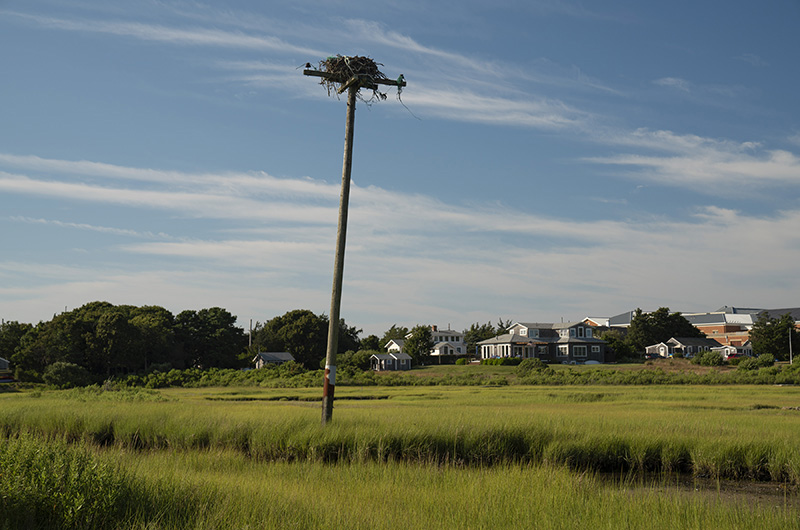
Salt marshes are superheroes. Our coastal wetlands store flood water, absorb carbon dioxide and filter pollutants.
They are the base of the marine food chain. A seminal 2007 Union of Concerned Scientists (UCS) report found that a third of all commercial fish and shellfish harvested in the Northeast coast depend on estuaries and wetlands for protection.
The federal Environmental Protection Agency too has recognized the role salt marshes play in the life cycle of up to 90 per cent of fish caught recreationally.
Those marshy areas that you see around saltwater ponds and in beach areas provide habitat for coastal and migratory birds and terrestrial plants and animals. They add to our quality of life through bird watching, kayaking, enjoyment of scenic views and artistic renderings.
And they do it all for free.
A 2017 Oak Bluffs study found that the services provided by the town’s public coastal resources — salt marshes, ponds and beaches — have a monetary value of over $150 million annually. The services include flood control, wildlife habitat and recreation. This is a valuable incentive for salt marsh preservation.
Yet our salt marshes are at risk of disappearing. Storms erode their edges. The marshes may be unable to grow high enough to keep pace with the rising sea.
If they can’t keep up, they will become open water. For example, if the Brush Pond salt marsh disappears, the Martha’s Vineyard Hospital property, surrounded by water on three sides, will be at greater risk for flooding.
In the natural process, marshes need to migrate inland to survive. Sometimes there are houses in the way, posing new challenges.
At the Felix Neck Wildlife Sanctuary on Sengekontacket Pond in Edgartown, a salt marsh restoration project is underway. Mass Audubon, which owns the sanctuary and its historic landscape, believes the project is an important prototype for saving marshland buffered by protected upland conservation land.
One way to protect salt marshes is by creating so-called living shorelines, such as the one at Felix Neck. Another method is what is known as thin layer deposition, where liquefied dredge material is sprayed on a marsh to raise the elevation.
Meanwhile, in a promising development, biologists and ecologists are learning new information about Phragmites, an invasive species long considered a scourge of the salt marsh because it crowds out native plants and decreases biodiversity. Some land managers have adopted the practice of eradicating Phragmites with glysophate, a chemical that until recently was thought to be harmless to the environment but is now classified as a probable carcinogen, toxic to birds and amphibians.
In fact we are learning that the reedy invasive plant could help fight the effects of climate change in salt marshes.
Phragmites build up more soil than native species, helping to raise the marshes and better protect them from erosion and sea level rise.
They also absorb nitrogen, the bane of our coastal ponds, most of it coming from residential septic systems.
In a recent field experiment, the Martha’s Vineyard Shellfish Group successfully harvested Phragmites and found that it aided nitrogen removal from saltwater ponds.
A Smithsonian Environmental Research Center study also found that the plant, with its high nitrogen content, is able to absorb three times the amount of carbon stored by native salt marsh plants. Phragmites spring up more readily in degraded wetlands; their very presence indicates that a marsh system is out of balance.
In his book, The New Wild, Why Invasive Species Will Be Nature’s Salvation, Fred Pearce writes that “many of those invading species accused of pushing out the natives have simply moved into an ecological space created by the decline of the natives.”
The author describes invasive species as “ . . . opportunists but also nature’s regenerators. They were often doing the jobs that natives could not accomplish.”
What should matter for conservationists, Pearce concludes, “is finding ways to help nature regenerate.”
Climate change is a crisis for humans and the built environment, but the natural world will adapt. Ecosystems are never in a state of sustained perfection. Species everywhere are on the move, adjusting to a warmer world. Some will disappear; others will thrive. Human interference may do more harm than good; as much as we’d like to, we can’t control everything. What we need to do is eliminate greenhouse gas emissions to slow the warming.
Perhaps phragmites, an unwelcome washashore, are here as part of a new ecological balancing act, one attuned to the nuances of a shaken world.
Liz Durkee lives in Oak Bluffs.
"salt" - Google News
December 20, 2019 at 12:03AM
https://ift.tt/2PDiDe2
Martha's Vineyard News | Salt Marshes to the Rescue - The Vineyard Gazette - Martha's Vineyard News
"salt" - Google News
https://ift.tt/36cjMPq
Shoes Man Tutorial
Pos News Update
Meme Update
Korean Entertainment News
Japan News Update
JOIN NOW !!!
ReplyDeleteDan Dapatkan Bonus yang menggiurkan dari dewalotto.club
Dengan Modal 20.000 anda dapat bermain banyak Games 1 ID
BURUAN DAFTAR!
dewa-lotto.name
dewa-lotto.com